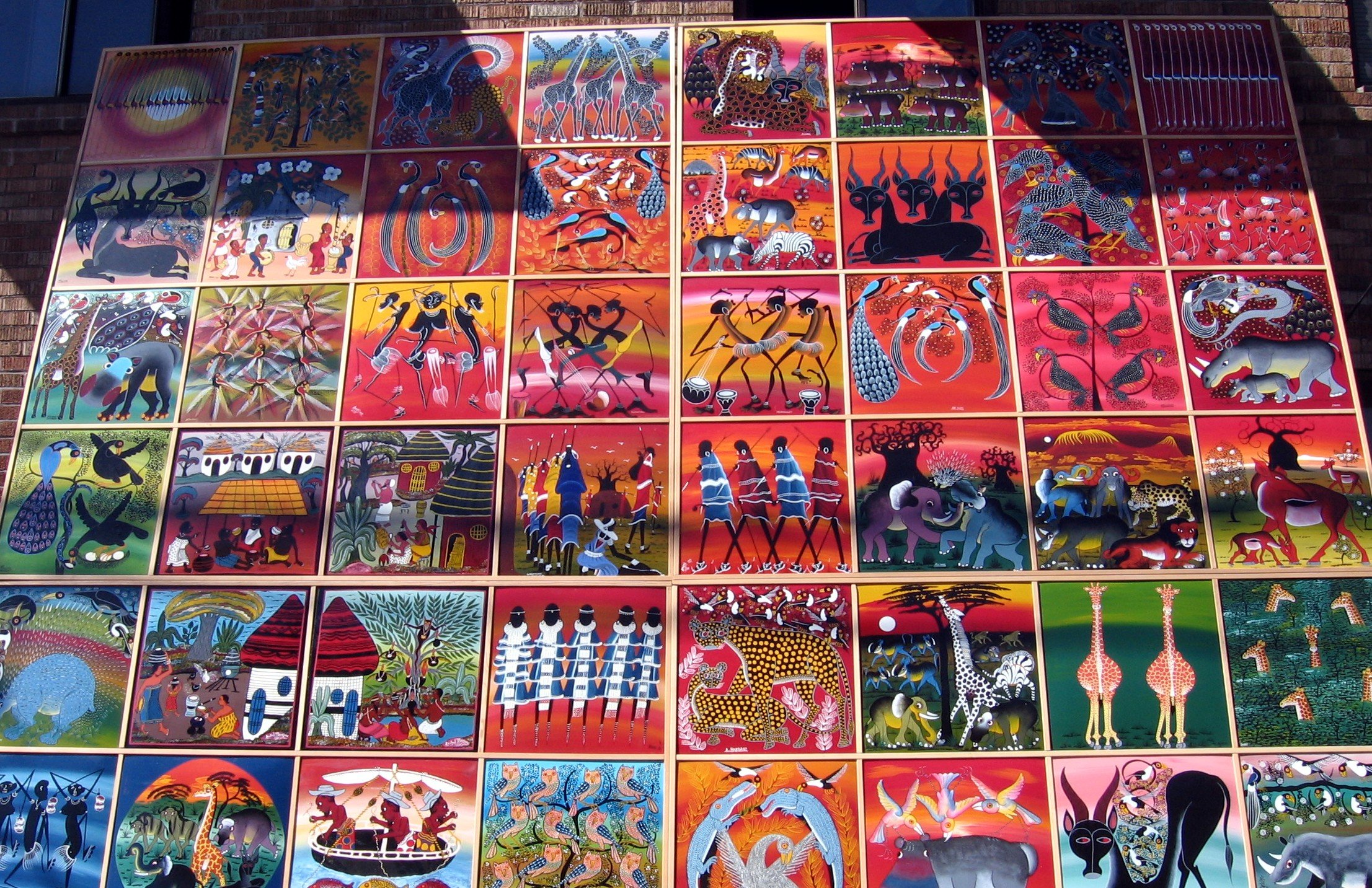Throughout East Africa, particularly where tourists are to be found, visitors are confronted with brightly coloured paintings of birds, animals, urban and village scenes. Its an art form that, while not exactly traditional, is certainly part and parcel of contemporary East African culture and an important element of the tourist industry.
And, extraordinarily, its provenance can be traced to one artist – Tingatinga.
Edward Saidi Tingatinga was thought to have been born in 1932 in a small village called Mindu, near Nakapanya in Tunduru District, in southern Tanzania, close by the Mozambique border.
In 1957 he left his village to seek his fortune, first travelling to the Tanga district and working on a sisal plantations before trying his luck in 1959 in the big city – Dar es Salaam.
He was fortunate enough to have a cousin, Salum Muussa (aka Mzee Lumumba) working as a cook for an expatriate European who was living in Msasani in the up-market suburb of Oyster Bay, north of Dar es Salaam’s city centre.
Tingatinga found employment at the same household as a gardener, but when their employer left Tanzania, the two cousins were obliged to move to Msasani, Mikoroshoni district.
Tingatinga was also very fond of traditional music. On many an evening he could be found drumming and dancing with a young Makonde group which is where he met his wife to be, Agatha Mataka with whom he had his first child, his son, Daudi.
In 1968 Tingatinga found a job as a ‘ward attendant’ at the Muhimbili Hospital, a public hospital run by the government’s Ministry of Health and Social Welfare. It was a modest salary, but being a government employee, a step up from being a gardener.
Mainly working evening or night shifts at Muhimbili Hospital, he found plenty of free time during the day. So he scraped together some money to buy a bicycle and became a street vendor. Each day he would visit the main fruit and vegetable market to buy produce and then cycle to the Oyster Bay district to sell from door to door.
He also began embroidering household linens, such as tablecloths and bed sheets, and wove baskets and mats to earn a living.
It is said that during this period he began offering his skills as a painter, decorating houses and making some wall paintings. From this activity he managed to collect unfinished tins of paint and scraps of hardboard and in his spare time he began painting animals and other scenes for his own amusement.
His wife was helping the household income by selling fruits and vegetables, as well as his crafts and his paintings, at the Oyster Bay shopping centre. Thanks to a tourist who bought one of Tingatinga’s paintings and began to promote his work, his paintings were soon in high demand.
Tingatinga quit his job at the clinic and took-up painting full time. He could even afford to employ several young relatives to assist him. His paintings were also selling, and thanks to a recommendation of a high-ranking advisor to the government’s National Development Corporation, the National Arts of Tanzania Ltd (NAT) was established to promote and sell Makonde wood sculptures and Tingatinga’s paintings.
His paintings were mainly of the wildlife he remembered from his rural childhood upbringing: birds, monkeys, lions, zebras, water buffalos, as well as farmers and fishermen with their catch and his favourite tree, the baobab. He also painted scenes from memory of the hospital where he had once worked.
A tragic end
Life was good for the artist, with NAT purchasing a fixed number of his works each week, but fate was to take a tragic turn in 1972.

Tingatinga was fond of spending the occasional evening drinking with friends in the many bars in Dar es Salaam.
One such night he was riding in a car to a bar with two friends – his cousin Tedo and another man, Daudi Issa Ndia, a car mechanic, who was the driver.
Unknown to Tingatinga and Tedo, the car actually belonged to the car mechanic’s customer and had been taken for ‘an evening test drive’.
There was a heavy police presence in the city looking for a gang of bank robbers who earlier that day had pulled off a daring raid in downtown Dar es Salaam.
As the car reach Dar es Salaam’s city centre and turned into Independence Avenue (now called Samora Avenue) they were confronted by a police roadblock.
Ndia panicked as he had no driver’s licence, no insurance and had not even been given permission to take the car. Swerving past the police, the driver tried to speed away from the roadblock.
The police opened fire, aiming for the tyres, but Tingatinga sitting on the back seat, was hit. He died later on the way to the hospital. He was just 40 years old and he left a wife and two children. After his death, his studio helpers continued to paint and make a living by continuing to hawk paintings at the Oyster Bay shopping centre until, in the mid 1990s, the Swiss Association for International Co-operation organised a successful exhibition in Switzerland where over 600 paintings were sold.
The legacy lives on
Other exhibitions were organised in Australia, Denmark, France, Germany and Japan – and from the resulting sales of paintings enough money was raised to build an art gallery at the Oyster Bay shopping centre.
Today, the Tingatinga Arts Cooperative Society has a gallery and workshops quite close to the Morogoro Stores where Tingatinga’s paintings were once sold by his wife.
Rogger Zaburi, the cooperative’s secretary, explained to African Business that 80% of the sale of paintings is paid to the artists while 20% goes towards the upkeep of the gallery.
While Oyster Bay may not be quite the exclusive suburb it once was, the gallery at the shopping centre still attracts many tourists. It’s relatively easy to find. Depending on your budget you either take a taxi or dala-dala (minibus) north from the city centre towards the Msasani Penisular – along Ali Hassan Mwinyi before turning onto Haile Salassi. Passing the US embassy on your right, then the Nigerian embassy on your left, you reach the Peninsula Hotel. Just 50m after the hotel is a small side road on the left.
At the end of this short road, perhaps 100m long, is the Tingatinga Co-operative Gallery, but along the road you’ll see a number of small studios where Tingatinga painters are hard at work.
These artists not only paint in a number of different styles and different subjects but also produce a variety of painted objects such as house signs and door numbers, or enamel plates and mugs. If you don’t see what you want, you can commission any of the artists and they’ll have your piece ready in a couple of days.
Although it is interesting to visit the place were the whole Tingatinga phenomena started, you hardly need to travel to Oyster Bay to find examples of the art. Wherever you are in East Africa, there are hundreds, perhaps thousands, of artists who paint in all manner of styles and covering a huge number of subjects. But they are all Tingatinga painters, and part of one of the most vibrant and successful of contemporary art movements in Africa.
Crédito: Link de origem


